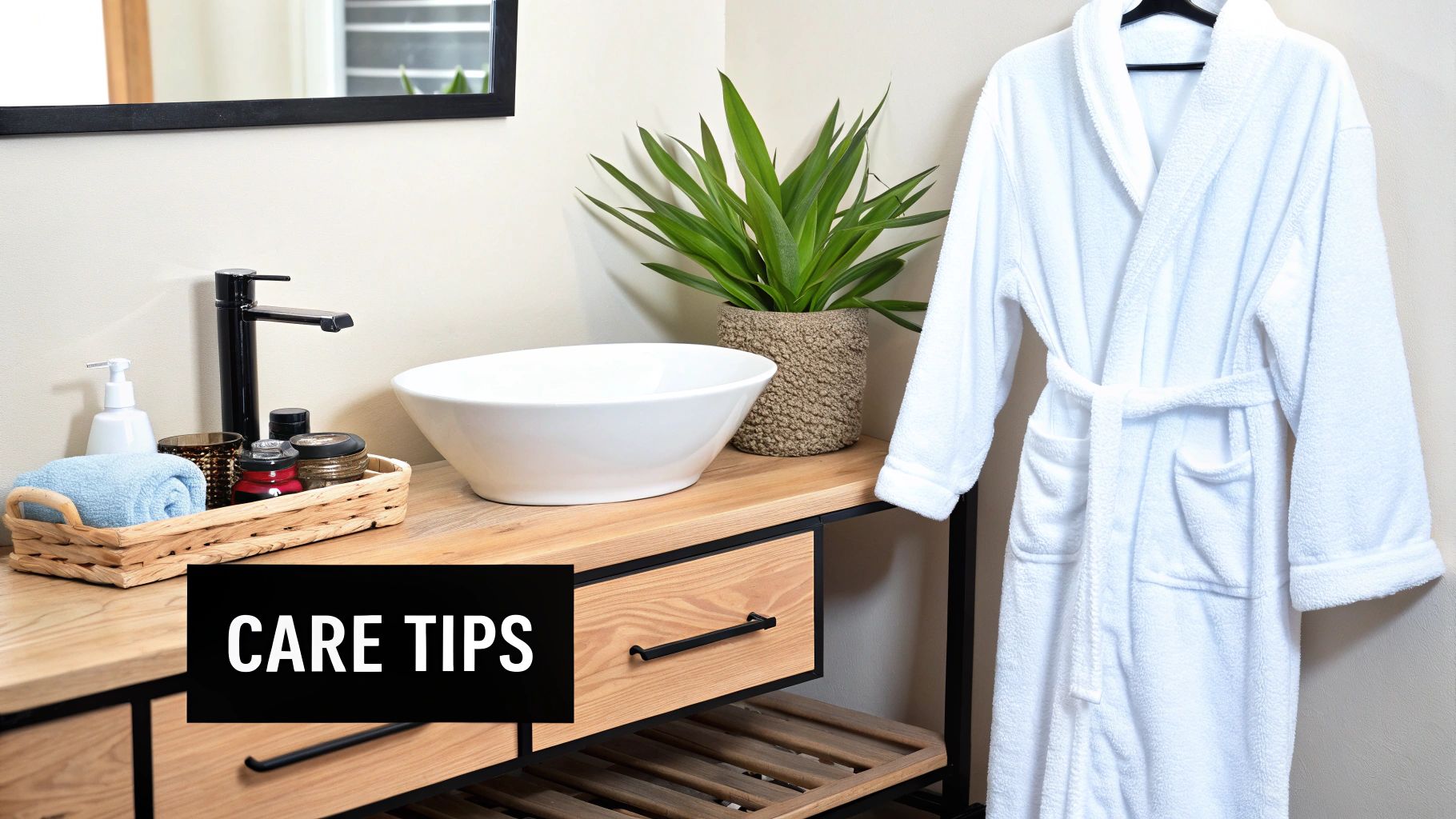Finding the right dressing gown here in NZ is all about finding that perfect sweet spot between pure comfort and a bit of everyday style, especially with our changeable weather. The best dressing gowns NZ has to offer can be anything from a thick, fleecy robe for those frosty winter mornings to a breezy, elegant wrap for relaxed summer evenings.
Your perfect match will come down to the right material, a great fit, and a design that just works for you, making it a go-to piece you'll reach for every single day.
Your Guide to Finding the Perfect NZ Dressing Gown
Let's find you a dressing gown you'll truly live in. This is more than just picking something to throw on after a shower; it's about choosing a key piece of loungewear that makes those quiet moments at home feel that much better. A great dressing gown is a small luxury, turning your morning cuppa or your evening wind-down into a proper ritual of relaxation.
Think of this as your personal guide to finding "the one." We'll walk through everything you need to consider so you can feel confident in your choice. For anyone who really wants to get into the nitty-gritty of how quality garments are made, from the fabric choice to the final stitch, you can delve into comprehensive sewing knowledge for garment insights.
What You Will Discover
In this guide, we’re going to break down the key things that make a dressing gown perfect for life in New Zealand. Forget the overwhelming choices—this is all about practical, straightforward advice that helps you zero in on what really counts.
Here's a look at what we'll cover:
- A Deep Dive into Materials: We'll compare the best fabrics for NZ's "four seasons in one day" climate, from snuggly fleece and warm wool to breathable cotton and linen.
- Getting the Sizing Right: Learn the tricks to reading size charts and taking your own measurements for a fit that’s both comfortable and flattering. No more awkward lengths or tight shoulders!
- Real-World Styling Tips: See how your gown can be more than just a robe. We’ll look at ways to make it a versatile part of your at-home wardrobe.
- Keeping it Like New: Get our best tips for washing and caring for your dressing gown so it stays soft and luxurious for years to come.
- Where to Find the Best: We'll point you to some great spots to shop, from local Kiwi boutiques to reliable online retailers.
By the time we're done, you'll have everything you need to choose a dressing gown that not only ticks all the practical boxes but also feels like it was made just for you.
Picking the Right Fabric for New Zealand Seasons
Choosing the material for your dressing gown is probably the most critical decision you'll make. This is especially true here in New Zealand, where the weather can throw a crisp southerly and a humid northerly at you all in the same day. The fabric doesn't just dictate warmth and feel; it determines how useful the gown actually is in your daily life. It’s what separates a robe that gets worn from one that just hangs in the wardrobe.
First, ask yourself what you really need it for. Is this for soaking up water straight out of the shower, or is it more of a light layer for lounging on a mild evening? Figuring this out will point you straight to the perfect fabric for your lifestyle.
For Ultimate Warmth and Cosiness
When a cold snap hits, especially in the depths of a South Island winter, you need a fabric that delivers instant warmth and comfort. These materials are all about trapping body heat and wrapping you in a personal cocoon.
- Fleece: There's a reason this synthetic material is so popular. It gives you incredible warmth without the weight, feeling light while providing serious insulation. It’s soft, tough, and a brilliant choice if your number one goal is staying toasty.
- Flannel: A true classic. Flannel is a woven cotton fabric that’s been brushed to raise the fibres. This 'napping' process creates that signature soft surface and tiny air pockets that trap heat beautifully, making it a warm yet breathable option.
- Thick Cotton Terry: Picture your most luxurious bath towel. Cotton terry is super absorbent and has a lovely, comforting weight to it, making it perfect for bundling up in after a hot shower on a chilly morning.
This decision tree can help you sort out what matters most, whether it's warmth, style, or post-shower practicality.

As the infographic shows, your main reason for wanting a gown points you directly to the best fabric, making the choice between functional absorbency and pure lounging comfort much clearer.
Dressing Gown Material Comparison for NZ Climates
To make things even easier, here’s a quick rundown of the most common fabrics you'll find. I've broken them down by what they're best for, how warm they are, and what it takes to look after them, keeping our Kiwi lifestyle in mind.
| Material | Best For | Warmth Level | Absorbency | Care Difficulty |
|---|---|---|---|---|
| Fleece | Deep winter warmth, lounging | High | Low | Low |
| Flannel | Cool nights, cosy weekends | Medium-High | Medium | Low |
| Cotton Terry | Post-shower, spa-like comfort | Medium | High | Low-Medium |
| Waffle Cotton | Year-round use, after a swim | Light-Medium | High | Low |
| Linen | Summer evenings, warm climates | Low | High | Medium |
| Silk/Satin | Luxurious lounging, special occasions | Low | Low | High |
Ultimately, the best fabric is the one that fits seamlessly into your daily routine, whether that involves a chilly walk to the mailbox or a relaxed morning coffee on the deck.
For Breathability and Lighter Comfort
For those milder climates or balmy summer evenings, a heavy robe is the last thing you want. Lighter, more breathable fabrics give you that bit of coverage and a touch of elegance without making you overheat. These are just the ticket for year-round use in warmer spots like Northland or the Bay of Plenty.
A lightweight gown brings a sense of relaxed sophistication. It’s less about battling the cold and more about elevating your downtime, turning a simple evening at home into something a bit more special.
Materials like lightweight cotton, linen, and silk or satin are perfect. They drape beautifully and feel cool against the skin, offering a layer of comfort without the bulk. To get a better handle on how different materials behave, you can explore the benefits of natural fabrics for clothes in our detailed guide.
While your choice is personal, it's interesting to see how market trends play a role. The women’s bathrobe market in New Zealand has recently seen a 5.2% drop, now sitting at about NZD $6.9 million. This kind of shift often means we’re all being more selective, choosing durable, versatile fabrics that offer real long-term value over fast-fashion trends.
How to Find a Flattering and Comfortable Fit
There’s nothing worse than a beautiful dressing gown that just doesn’t fit right. Sleeves that are always in the way, a wrap that gaps open, or tight shoulders can quickly turn a piece of luxury into a daily annoyance. Nailing the fit is absolutely crucial for comfort, ensuring your gown moves with you, not against you.
The first trick is to look past the standard S, M, and L labels. These sizes can be wildly inconsistent from one brand to another, which often leads to a disappointing fit. If you're buying dressing gowns nz online, taking a few key measurements at home is a must. It only takes a couple of minutes, but it makes all the difference.
Key Measurements for the Perfect Fit
To get a gown that feels like it was made just for you, focus on four crucial measurements. These will help you make sense of any size chart and choose with confidence.
-
Shoulder Seams: The seam connecting the sleeve to the body of the gown should sit right on the edge of your shoulder bone. If it's slipping down your arm, it's too big. If it’s creeping up toward your neck, it’s too small and will feel restrictive.
-
Sleeve Length: For the best fit, the sleeve should end right at your wrist bone. This keeps you warm and covered without the cuff getting dunked in your morning coffee or getting in the way at the sink.
-
Overall Length: This one really comes down to personal preference. A mid-calf length is a popular choice, offering a great balance of warmth and ease of movement. Shorter, knee-length styles are fantastic for warmer weather or for anyone who prefers a bit less fabric.
-
Wrap Circumference: Make sure the gown can wrap around you with a generous overlap—aim for at least 20-30 cm. This is the secret to making sure it stays securely closed and doesn't gape open when you sit down or move about.
A quick tip from experience: always think about what you’ll be wearing underneath. If you love cosying up in bulky pyjamas, you might want to size up to make sure there's enough room to move freely without feeling constricted.
Understanding Your Shape and Style
Once you have your measurements, think about how different cuts might work for your body. The right style won't just be comfortable; it'll make you feel fantastic. Knowing your body shape is a great starting point, and for more in-depth tips, this guide on dressing effectively for your body type is incredibly helpful.
For instance, a gown with a classic tie-waist will give you a lovely, defined silhouette. On the other hand, a straight-cut kimono style offers a more relaxed, minimalist drape. You'll also find that unisex gowns are often designed with a straighter cut and broader shoulders, while women's or men's specific designs tend to be more tailored through the body. There's no single "best" option—it's all about finding what makes you feel completely at ease in your own space.
Integrating Your Gown into Everyday Style
The lines between what we wear to lounge around the house and what we wear out have thankfully started to blur. A beautiful dressing gown is far too lovely to be kept just for the bedroom; it can actually be one of the most versatile pieces in your wardrobe, adding a touch of easy elegance to even the simplest outfit. It's time to see your gown as more than just practical—it's a fashion statement waiting to happen.
Think about that silky, kimono-style robe you have. Instead of just throwing it over your PJs, picture it worn open over a classic white tee and your favourite pair of jeans. Instantly, you’ve created a chic, flowing layer that lifts a casual look into something special. It’s the perfect outfit for a relaxed weekend brunch at home or even a casual get-together with friends on the deck.

This whole idea taps into a bigger shift in how we think about comfort and style, and you can see it in the way many Kiwi designers are creating pieces that are both gorgeous and incredibly functional. This isn't just a local trend, either. New Zealand's knack for this niche is clear on the world stage—in a single year, our exports of women's dressing gowns from man-made fibres were valued at around USD $602,860. You can dive deeper into these NZ trade insights from the World Bank to see for yourself.
From Lounging to Layering
The trick to making your dressing gown work as an outer layer is all about getting the balance right. Essentially, you want to treat it like a light duster coat or a long, flowing cardigan. The key is to pair its relaxed shape with more structured, fitted pieces underneath so you don't get lost in all that fabric.
A few simple styling tips can make a world of difference:
- Define Your Waist: If your gown feels a bit shapeless, try swapping its fabric tie for a smart leather belt. Cinching it at the waist creates a more polished silhouette that looks deliberate and stylish.
- Play with Proportions: A longer, flowing robe looks fantastic paired with skinny jeans or leggings. The contrast between the billowy top layer and the slim-fit bottom half is really flattering.
- Roll Up the Sleeves: Casually pushing or rolling the sleeves up to a three-quarter length breaks up the line of the garment and adds a touch of effortless cool.
The secret is to make it look intentional. When you thoughtfully pair your gown with everyday clothes, it stops being sleepwear and becomes a chic, versatile layering piece that shows off your personal style.
Elevating Your At-Home Style
Even if your gown is strictly for home, you can still style it to feel a bit more special. Thinking about your at-home accessories is a lovely little act of self-care that can make a quiet Sunday morning feel luxurious.
Consider pairing your gown with some elegant slippers, a delicate necklace, or even just taking a moment to do your hair. It’s these small, thoughtful touches that transform a comfortable dressing gown into a complete, curated look for relaxing in style.
Essential Care Tips to Make Your Gown Last
When you find that perfect dressing gown, it’s more than just clothing; it's an investment in your daily comfort. To keep it feeling as soft, vibrant, and perfectly shaped as the day you brought it home, a little care goes a long way. The right laundry habits protect the fabric, ensuring your cosy companion lasts for years, not just a few seasons.
You wouldn’t wash a delicate silk robe the same way you’d treat a sturdy cotton one, right? Different materials need different handling. Thankfully, a few small tweaks to your washing and drying routine are all it takes to keep your favourite loungewear in top condition.

Washing Your Gown the Right Way
First things first: always check the care label. It’s your single most reliable source of information. That said, there are some good general rules of thumb for the most common materials you’ll find in dressing gowns NZ wide.
For natural fibres like cotton, bamboo, and most linens, a gentle machine wash in cool or warm water is your best bet. Hot water is the enemy here—it can cause shrinkage and make colours fade much faster. I always recommend a mild, eco-friendly detergent that gets the job done without being harsh on the fibres.
Here are a few extra pointers for specific fabrics:
- Cotton Terry & Waffle: Pop these in the wash with similar colours. Try to keep them separate from anything with zips or hooks that could catch and pull on the loops.
- Fleece: To stop it from pilling, turn your fleece gown inside out before washing. And here’s a crucial tip: skip the fabric softener. It actually clogs the fibres over time, making them less soft.
- Silk & Satin: These luxurious fabrics really need a bit of special treatment. It's best to hand-wash them in cool water using a detergent made specifically for delicates. Never wring them out; just gently squeeze the excess water away.
Taking a moment to separate your gown and use the correct cycle is the single most effective thing you can do to extend its life. It’s a small effort that pays off with every wear.
Drying and Storing for Longevity
How you dry your dressing gown is just as important as how you wash it. The intense heat from a tumble dryer can be brutal on most fabrics, leading to wear and tear, shrinkage, and a loss of that plush, cosy feel.
Whenever you can, air-drying is always the better option. Hang your gown on a sturdy, padded hanger or lay it flat on a drying rack. Just keep it out of direct sunlight, which can fade the colour. This gentle approach helps the garment keep its original shape and texture. If you absolutely have to use a dryer, stick to the lowest heat setting or an air-fluff cycle. For cotton gowns, tossing in a few wool dryer balls can help fluff up the pile and even speed up the drying time.
Finally, a quick word on storage. Don’t hang heavy gowns on thin wire hangers, as this will stretch out the shoulders over time. A broad wooden or padded hanger is a much better choice. And always make sure the gown is completely dry before you put it away to avoid any musty smells.
For fabrics like linen, which get better with age if cared for properly, you can find more detailed advice in our guide on washing and caring for luxury European linen.
Where to Find Quality Dressing Gowns in NZ
Knowing what makes a great dressing gown is one thing, but actually finding it is the next challenge. The good news is that the New Zealand market is full of fantastic options, from the big-name department stores we all know to gorgeous local boutiques.
It really comes down to how you prefer to shop. Do you need to feel the fabric between your fingers, or are you happy scrolling through endless choices online? Either way, there's a perfect retailer out there for you. The trick is knowing where to look for garments that offer real comfort and will last for years, not just a tempting price tag.
Trusted Department Stores and Local Favourites
For a lot of Kiwis, the first stop is often a familiar department store like Farmers or Smith & Caughey's. They’re brilliant for convenience, letting you see a huge range of brands, styles, and prices all in one place. It’s a massive advantage being able to compare a plush fleece robe right next to a lightweight cotton one.
But if you’re after something a bit different, the local scene is where the magic happens. Independent boutiques and specialised homeware stores are treasure troves for unique, thoughtfully designed pieces. They often stock dressing gowns from smaller NZ designers or curated international brands you just won't find anywhere else. It's well worth popping into these smaller shops to discover something truly special.
Exploring the Best Online Retailers
Online shopping has completely opened up the possibilities for anyone hunting for the perfect dressing gowns nz. Retailers who live and breathe high-quality textiles, like us at The Foxes Den, have already done the groundwork by curating collections that champion beautiful materials and solid craftsmanship. This is a huge help for men looking for specific styles, and we've put together a dedicated guide on finding a men's dressing gown NZ with more specific advice.
On top of local online stores, many international brands now ship directly to New Zealand, giving you access to global trends right from your sofa.
When you're buying a dressing gown online, my best advice is to become a detective. Pay close attention to the fabric composition, triple-check the retailer’s size guide against your own measurements, and always, always read the customer reviews. These details are your best defence against disappointment.
It's interesting to look at the wider market for these garments in New Zealand. While import numbers have stayed fairly consistent, NZ's overall share of regional imports has dipped slightly. This could point to a mature market or perhaps a growing Kiwi interest in different types of loungewear. If you're a numbers person, you can discover more insights about these market trends on IndexBox.
Got Questions? We’ve Got Answers
Choosing the right dressing gown can spark a few questions. Here are the answers to some of the most common things people ask when they're on the hunt for the perfect one in New Zealand.
How Often Should I Be Washing My Dressing Gown?
Honestly, it all comes down to how you wear it. If you're just popping it on over your PJs for a bit of extra warmth, washing it after every 3-4 wears is perfectly fine.
However, if you're using it to dry off straight out of the shower, you’ll want to treat it more like a towel and wash it more often to keep it feeling and smelling fresh. Remember, washing less is not only better for the environment but also helps your gown stay in great shape for longer.
What’s the Real Difference Between a Bathrobe and a Dressing Gown?
Good question! Technically, a bathrobe is designed for absorbency – think fluffy cotton terry that’s perfect for post-shower drying. A dressing gown, on the other hand, is traditionally all about warmth and comfort for lounging over your sleepwear.
Here in NZ, though, we tend to use the terms interchangeably. You'll find plenty of modern styles, like those made from waffle cotton or lovely linen blends, that are fantastic at doing both jobs.
My advice? Don't get too hung up on the name. Just think about what you need it for most – drying off or cosying up – and let the fabric guide your choice.
Can I Find Eco-Friendly Dressing Gowns in NZ?
You certainly can. More and more Kiwis are looking for sustainable choices, and local and international brands are definitely taking note.
You’ll find beautiful dressing gowns made from materials like organic cotton, bamboo, and linen. These natural fibres are a fantastic alternative to synthetics like polyester, which can release microplastics into our waterways. Just keep an eye out for brands that are open about where their materials come from and how their products are made.


